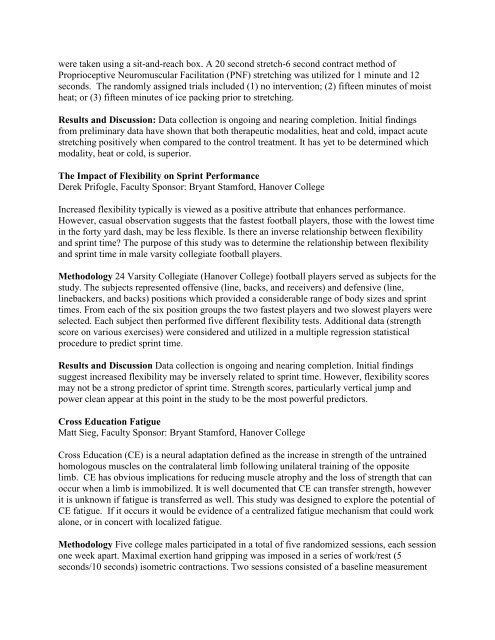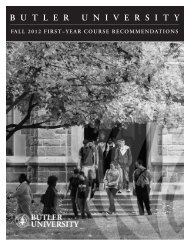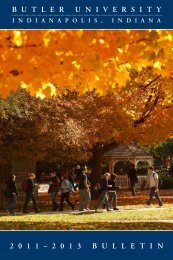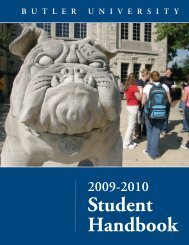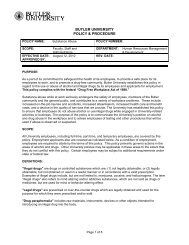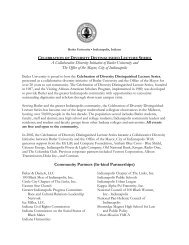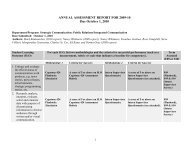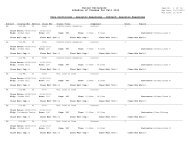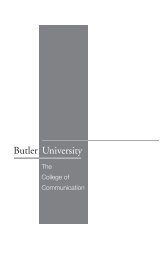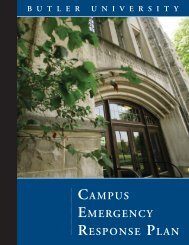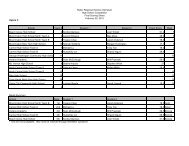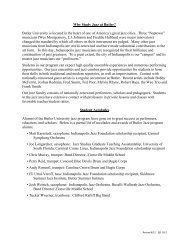Anthropology - Butler University
Anthropology - Butler University
Anthropology - Butler University
Create successful ePaper yourself
Turn your PDF publications into a flip-book with our unique Google optimized e-Paper software.
were taken using a sit-and-reach box. A 20 second stretch-6 second contract method of<br />
Proprioceptive Neuromuscular Facilitation (PNF) stretching was utilized for 1 minute and 12<br />
seconds. The randomly assigned trials included (1) no intervention; (2) fifteen minutes of moist<br />
heat; or (3) fifteen minutes of ice packing prior to stretching.<br />
Results and Discussion: Data collection is ongoing and nearing completion. Initial findings<br />
from preliminary data have shown that both therapeutic modalities, heat and cold, impact acute<br />
stretching positively when compared to the control treatment. It has yet to be determined which<br />
modality, heat or cold, is superior.<br />
The Impact of Flexibility on Sprint Performance<br />
Derek Prifogle, Faculty Sponsor: Bryant Stamford, Hanover College<br />
Increased flexibility typically is viewed as a positive attribute that enhances performance.<br />
However, casual observation suggests that the fastest football players, those with the lowest time<br />
in the forty yard dash, may be less flexible. Is there an inverse relationship between flexibility<br />
and sprint time? The purpose of this study was to determine the relationship between flexibility<br />
and sprint time in male varsity collegiate football players.<br />
Methodology 24 Varsity Collegiate (Hanover College) football players served as subjects for the<br />
study. The subjects represented offensive (line, backs, and receivers) and defensive (line,<br />
linebackers, and backs) positions which provided a considerable range of body sizes and sprint<br />
times. From each of the six position groups the two fastest players and two slowest players were<br />
selected. Each subject then performed five different flexibility tests. Additional data (strength<br />
score on various exercises) were considered and utilized in a multiple regression statistical<br />
procedure to predict sprint time.<br />
Results and Discussion Data collection is ongoing and nearing completion. Initial findings<br />
suggest increased flexibility may be inversely related to sprint time. However, flexibility scores<br />
may not be a strong predictor of sprint time. Strength scores, particularly vertical jump and<br />
power clean appear at this point in the study to be the most powerful predictors.<br />
Cross Education Fatigue<br />
Matt Sieg, Faculty Sponsor: Bryant Stamford, Hanover College<br />
Cross Education (CE) is a neural adaptation defined as the increase in strength of the untrained<br />
homologous muscles on the contralateral limb following unilateral training of the opposite<br />
limb. CE has obvious implications for reducing muscle atrophy and the loss of strength that can<br />
occur when a limb is immobilized. It is well documented that CE can transfer strength, however<br />
it is unknown if fatigue is transferred as well. This study was designed to explore the potential of<br />
CE fatigue. If it occurs it would be evidence of a centralized fatigue mechanism that could work<br />
alone, or in concert with localized fatigue.<br />
Methodology Five college males participated in a total of five randomized sessions, each session<br />
one week apart. Maximal exertion hand gripping was imposed in a series of work/rest (5<br />
seconds/10 seconds) isometric contractions. Two sessions consisted of a baseline measurement


